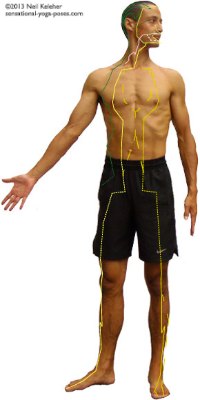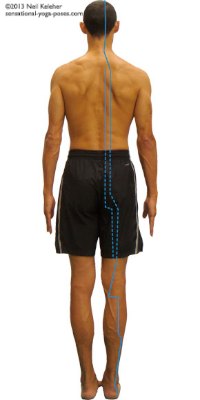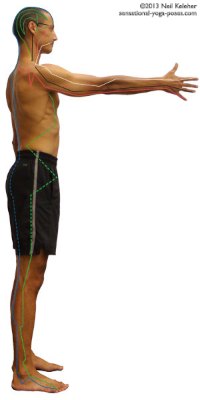Meridian Stretches
Increasing Flexibility, Deepening Body Awareness
Meridian stretches work on the connective tissue within the belly of the muscle being stretched.
So that this connective tissue can be stretched it is important to focus on relaxing the muscle being stretched.
So that the target muscle can relax you may find it helpful to give that target muscle a stable foundation.
You may also find it helpful to move into any stretch slowly, smoothly and with control.
What are the Meridians and where are they located?
The meridians are a network of tension channels that run across the surface of the body and within it. They transmit tension between muscles and organs.
The connective tissue network of the body is what "contains" the meridians.
Guidelines For Stretching
Create a Stable Foundation
To stretch leg muscles that attach to the feet you can give those muscles a stable foundation by activating your feet, and ankles, i.e. making them strong. You can shape your foot according to whether you are standing on it, in which case you can use it to press into the floor, or whether it is free, in which case the feeling might be like pulling on a shoe, boot, sock or stocking.
To stretch leg muscles that attach to the pelvis or spine you can focus on making the spine stable by using your abdominals, spinal erectors or both at the same time. You may also find it helpful to use your side gluteals.
Move Slowly and Smoothly
So that you can keep your target muscle relaxed, try moving into any stretch smoothly and slowly so that you can feel said muscle. If you have control you can pause at any time you feel your target muscle tensing. You can then focus on allowing it to relax at which point you can then continue to move deeper into the stretch.
How to stretch a meridian
To stretch a particular meridian you can simply focus on stretching along the line that the meridian runs. Note, because each meridian crosses several joints and muscles, you may have to stretch a meridian section-by-section.
So that we can do that it can be helpful to learn the pathways of the 12 ordinary meridians.
Once you know the pathway of each meridian you can figure out how to stretch the meridians or energize them or you can analyze a posture or action to see which meridians are being stretched or energized.
If a meridian crosses the front of the hip (like the stomach meridian does) then you can stretch the meridian at that location by opening the front of the hip. You can reach one leg back in a lunge so that the front of the hip of that leg is stretched.
Where a meridian runs along the length of a muscle then you can lengthen that muscle. As an example the stomach meridian runs down the front of the leg along the rectus femoris muscle. This muscle attaches between the front of the pelvis and the front of the knee. You can stretch this muscle and the stomach meridian by tilting your pelvis back while the knee is bent. (Reclining Hero Pose)
For a complete stretch of the stomach meridian you can stretch the front of the ankle as well as the front of the belly and ribcage.
The better you know or understand the meridian network the easier it is to build a routine of meridian stretches that stretches the bodies connective tissue completely.
For a more detailed explanation of the meridian network read Meridians.
Stretching the Yin Organ Meridians
If you hold your arms up over your head, then the Yin organ meridians all run upwards up the inner thighs and up the fronts of the arms.
Yin Organs are as follows: Liver, Lung, Spleen, Kidneys, Pericardium
The Yin Organ meridians connect to the Yang Organ meridians at the fingers.
Liver and Lung Meridians
Liver-Lung
The Liver Meridian (green) runs up the center of the inner thigh between the kidney and spleen meridians.
It connects to the lung meridian at the front of the shoulder.
The Lung Meridian (white) runs down the outside edge of the front of the arm to the thumb.
Liver Meridian Stretches
- Liver meridianstretches include stretching the inner thighs and twisting the torso.
Lung Meridian Stretches
- Lung meridianstretches can include stretching the front of the shoulder and wrist.
Spleen and Heart Meridians
Spleen-Heart
The Spleen Meridian (yellow) runs along the front edge of the inner thigh.
It starts at from the top of the big toe. Running up the torso it follows a line to the outside of the stomach meridian. It connects to the heart meridian at the shoulder.
The Heart Meridian (red) runs along the inside edge of the front of the arm ending at the pinky.
Spleen Meridian Stretches
- Spleen meridianstretches can include stretching the inner thighs and twisting the torso.
Heart Meridian Stretches
- Heart meridianstretches include stretching the front of the shoulder and wrist.
Kidney and Pericardium Meridians
Kidney-Pericardium
The Kidney Meridian runs up the back line of the inner thigh.
It starts at the bottom of the foot from the the little toe back and to the inside edge of the foot where it follows the inside of the arch to then do a circle around the inside of the ankle.
It then ascends the back edge of the inner thigh to the perineum and then runs up the front of the body close to the center line, connecting to the collar bone just inside the point where it connects to the sternum.
The Pericardium Meridian runs down the center line of the front of the arm to the tip of the middle finger.
Kidney Meridian Stretches
- Kidney meridianstretches include lengthening the inner thigh muscles (the adductors) and twisting the torso.
Pericardium Meridian Stretches
Stretching the Yang Organ Meridians
If you hold your arms up over your head then the Yang organ meridians all flow (mostly) downwards along the back of the arms, the neck and along the front, sides and back of the body and legs. They connect to the Yin meridians at the feet.
Large Intestine and Stomach Meridians
Large Intestine-Stomach
The Large Intestine Meridian (white) starts at the index finger and runs up the outside edge of the back of the arm.
From there it runs up the neck and across the space between the bottom of the nose and the top of the upper lip, crossing the body's center line to connect to the stomach meridian (yellow).
The Stomach Meridian runs down the front of the body. Running down the torso it crosses the nipple and runs down the outside edge of the rectus abdominus and down the front of the thighs and lower leg to the foot where it connects to the big toe and the second toe.
Large Intestine Meridian Stretches
- Large intestine Meridianstretches can include stretching the back of the wrist, shoulder and also stretches for the neck.
Stomach Meridian Stretches
- Stomach meridianstretches can include stretching the front of the neck, lengthening the abdominals, opening the front of the hip, stretching the front of the thighs and the front of the ankles.
Small Intestine Meridian and Bladder Meridian
Small Intestine-Bladder
The Small Intestine Meridian (red) runs up the back of the arm along the inside edge. It starts from the back side of the pinky. It zigzags across the spine of the shoulder blade, runs up the side of the neck to the outer corner of the eye and then to a point just in front of the ear.
The Bladder Meridian (blue) runs down the back of the body and back of the leg.
It starts at the inside corner of the eye, runs over the top of the head and down the back of the body. To either side of the spine it has two lines on each side. These two lines zag outwards and down at the buttock and then recombine to form one line just behind each knee.
The Bladder Meridian then runs down the back of the calf to the outside of the heel and down the outside of the foot. It ends at the tip of the small toe where it then connects to the Kidney Meridian.
Small Intestine Meridian Stretches
- Small intestine meridianstretches include stretching the back of the wrist, shoulder and also include stretching the neck.
Bladder Meridian Stretches
- Bladder MeridianStretches include stretching the back of the neck, back of the spine, buttocks, hamstrings and calves.
Triple Heater Meridian and Gall Bladder Meridian
Triple Heater-Gall Bladder
The Triple Heater Meridian runs up the center of the back of the arm from the ring finger. It ascends the neck and circles behind the ear.
The Gall Bladder Meridian runs down the side of the body and side of the leg. It starts from in front of the ear, and coils back and forwards along the side of the head, each zag taking it higher up the skull. It then descends down the front of the shoulder and down the side of the body.
Triple Heater Meridian Stretches
- Triple heater meridianstretches include stretching the back of the wrist, shoulder and stretching the side of the neck.
Gall Bladder Meridian Stretches
- Gall bladder meridianstretches include stretching the side of the neck, side of the ribcage and waste and the side of the legs.
Stretching Summary:
Published: 2013 12 02






